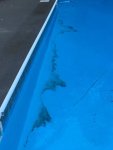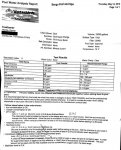My wife and I purchased a house in January that has an in-ground pool and so far its been a battle. We've had to replace our pump and now we have some serious staining going on along one side of our pool. I've used a chlorine tab to scrub the stain but it didn't remove anything. I've used "Stain Free" treatment and it didn't do anything and I've used a copper stain remover which didn't do anything. A person at the pool store said to use ph down on the stain and it did work in one area but I didn't have enough to treat the larger stain. So I've spent over $60 trying to remove this and nothing as worked so looking for some advice.

Pool Stain Identification and Treatment
- Thread starter dhenke
- Start date
You are using an out of date browser. It may not display this or other websites correctly.
You should upgrade or use an alternative browser.
You should upgrade or use an alternative browser.
Hi, welcome to TFP! Can you post a complete set of test results? Did the previous owner leave any chemicals that might indicate what was put into the pool?
I have never seen a stain like that before.
That said, stains are either organic or inorganic.
To test for organic stains, hold a tri-chlor puck onto the stain for a couple of minutes and then remove. If the stain is gone or noticeably lightened, the stain is almost surely organic.
Inorganic stains (metals) can be tested by taking vitamin C tablets and crushing them up in a sock and then holding the sock directly onto the stain for at least a couple of minute....five minutes wouldn't hurt.
Figure out what type of stain you have and then we'll help you remove it.
Stop putting stuff in your water until you identify that stain.
That said, stains are either organic or inorganic.
To test for organic stains, hold a tri-chlor puck onto the stain for a couple of minutes and then remove. If the stain is gone or noticeably lightened, the stain is almost surely organic.
Inorganic stains (metals) can be tested by taking vitamin C tablets and crushing them up in a sock and then holding the sock directly onto the stain for at least a couple of minute....five minutes wouldn't hurt.
Figure out what type of stain you have and then we'll help you remove it.
Stop putting stuff in your water until you identify that stain.
I have to start out stating that pool store testing is notoriously unreliable. It is a loss-leader designed to get you in the store so they can sell you all sorts of chemicals (as witnessed from their recommended purchases on the printout) and then get you to build up a dependency on them. If you're serious about following our process, the first step is to order one of the Recommended Test Kits.
Having said that, it's showing that your FC is way too low for your CYA level. If this situation has persisted for some time, what you are seeing is very likely algae. Judging from the pic, it could be black algae. Although the trichlor puck test is usually a good test to distinguish a stain from algae or metals, it may not show the expected results as quickly on black algae vs. other types since it embeds itself into plaster and had a tough external coating to protect itself from chlorine. You didn't state what type of surface your pool has, but it looks like plaster although the pool store printout says vinyl. Can you clarify which before we go any further? I will close (for now) by stating that there is a way to remove and eradicate black algae, so don't despair. But first, let's get a better handle on whether that's what we are dealing with here.
A final question- do you use well water or municipal water to fill your pool?
Having said that, it's showing that your FC is way too low for your CYA level. If this situation has persisted for some time, what you are seeing is very likely algae. Judging from the pic, it could be black algae. Although the trichlor puck test is usually a good test to distinguish a stain from algae or metals, it may not show the expected results as quickly on black algae vs. other types since it embeds itself into plaster and had a tough external coating to protect itself from chlorine. You didn't state what type of surface your pool has, but it looks like plaster although the pool store printout says vinyl. Can you clarify which before we go any further? I will close (for now) by stating that there is a way to remove and eradicate black algae, so don't despair. But first, let's get a better handle on whether that's what we are dealing with here.
A final question- do you use well water or municipal water to fill your pool?
^ I too will await more info, but your sheet from the pool store says "alt sanitizer: mineral system" -- if this is true and you do have a mineral sanitizer system, you will want to remove it because its adding metals to your water!
Sorry for the late response and the lack of a signature. I just got AquaChek 7 test strips and the results were total alkalinity 85, pH 7.3, hardness 300, CYA 42, free chlorine between 0 and 0.5, total chlorine between 0 and 0.5. After this reading I added 2 pounds of 54% calcium hypochlorite shock to the pool.
I also received Jack's magic stain identification kit in the mail today and waiting for the shock to dissolve before testing stains.
with the nature2 system I only currently have chlorine pucks in it and have not replaced the mineral cartridge so I imagine that it's empty.
I also received Jack's magic stain identification kit in the mail today and waiting for the shock to dissolve before testing stains.
with the nature2 system I only currently have chlorine pucks in it and have not replaced the mineral cartridge so I imagine that it's empty.
Empty is good 
Keep us posted on the stain ID.
Also brush up on FC:CYA levels and get your FC up...while you may end up needing to SLAM, you'll want to know whether you're dealing with metals or not first...because you not want to oxidize the metal without sequestering it.
Lastly, and more on this later if needed, there IS a rare phenom where there can be an underliner growth that cause the appearance of a stain that defies testing or removal.
There are treatment options in that case but you need to first rule out just about everything else, including organics via slamming.
Keep us posted on the stain ID.
Also brush up on FC:CYA levels and get your FC up...while you may end up needing to SLAM, you'll want to know whether you're dealing with metals or not first...because you not want to oxidize the metal without sequestering it.
Lastly, and more on this later if needed, there IS a rare phenom where there can be an underliner growth that cause the appearance of a stain that defies testing or removal.
There are treatment options in that case but you need to first rule out just about everything else, including organics via slamming.
Thread Status
Hello , This thread has been inactive for over 60 days. New postings here are unlikely to be seen or responded to by other members. For better visibility, consider Starting A New Thread.



